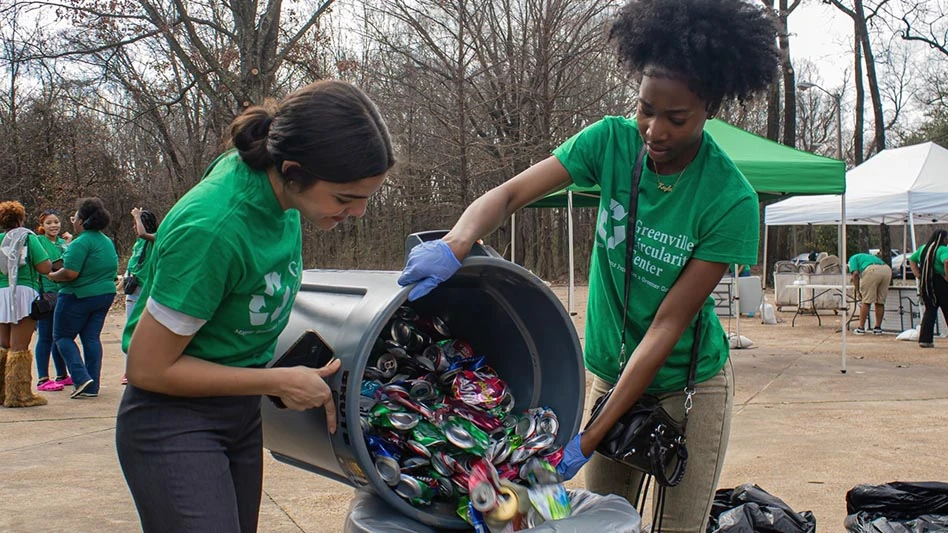
2020 has been a tumultuous year for the recovered fiber industry. COVID-19 lockdowns early in the year led to panicked buying and disrupted supply chains. Generation patterns were altered as individuals turned to online shopping and many found themselves working from home instead of at the office. More recently, the effects of China’s ban on all recovered fiber imports beginning in 2021 already were being felt in the market, with pricing for double-sorted old corrugated containers (OCC) falling in the October buying period.
Given the chaos, it’s no surprise that two mill buyers spoke to the benefits of long-term relationships with their suppliers during the Mill Buyers Roundtable during the Paper & Plastics Recycling Conference International, a broadcast event that Recycling Today hosted online from Oct. 20-22.
Moderated by Bill Moore, president of the paper recycling and sustainability consultancy Moore & Associates, Atlanta, the panelists were Edward Tucciarone, the St. Louis-based director of secondary fiber for Graphic Packaging International Inc., which is headquartered in Atlanta; and Tomasz Patyra, group category manager at Stora Enso. Patyra works out of Poland for the Helsinki-based paper and packaging manufacturer, buying for mills in Poland and Finland.
Quality relationships
Patyra said Stora Enso seeks to build and maintain long-term partnerships with its suppliers with an eye toward implementing process improvements along the entire supply chain by exchanging knowledge and experience.
Supplying quality recovered fiber contributes to a lower “cost of ownership” for Stora Enso, he said, by reducing the amount of waste the company has to manage at its mills, extending the life of its equipment and enabling the company to produce premium-quality containerboard.
Patyra said Stora Enso’s process for qualifying its suppliers is similar to Graphic Packaging’s approach as described by Tucciarone: “We have a standard operating procedure manual that we use that all suppliers have to sign off on. It is very detailed. It tells them exactly what they need to know for doing business with us.”
New suppliers of postconsumer grades to Graphic Packaging must go through a qualification program that involves sending trial loads to the company’s mills. Additionally, suppliers’ loads are audited several times per year, and a Graphic Packaging representative does an on-site inspection of the supplier.
“It’s not as big a concern for the preconsumer grades,” Tucciarone said.

He added that Graphic Packaging has longstanding relationships with many of its suppliers. “These relationships go back years and years, so they know what we want.
“We try not to bring in new sources if we don’t have to,” Tucciarone continued. “But we do an audit process to allow them.”
When Moore asked the panelists what their suppliers do that “irks” them most, Patyra said it was shortsightedness. When COVID-19 struck Europe, he said, “Some suppliers were trying to take, let’s say, unhealthy advantage of this situation. And there was a lot of speculation, and some of them behaved like a flag on the wind.”
He continued, “We know this market is in constant motion. And that’s why I do believe that building strong relationships opens a lot of opportunities that not everyone has. And, in this case, we found out our situation with good, reliable partners really helped us a lot.”
Tucciarone said Graphic Packaging has developed trust with its suppliers, who understand that give and take are necessary. “The recognition that we both need each other goes a long way.”
Managing inventory
While Graphic Packaging did not see any issues arise around quality early in the COVID-19 pandemic, Tucciarone said, the company did work to shore up its recovered fiber inventory. “We did buy initially some extra tons that we put into a warehouse, not knowing the future of what the material generation was going to be. That was something that was out of the ordinary for us. But, generally speaking, all of the grades that we needed, we were able to get.”

Photo courtesy of Graphic Packaging
Tucciarone said Graphic Packaging mills generally keep 10 days of recovered paper inventory on hand. “Because we’re a CRB (coated recycled paperboard) mill, we have a lot of different grades. Some grades that are a little harder to get—overissue [news] and lightly printed SBS (solid bleached sulfate board)—we might keep more days more plentiful. Corrugated we might have a little bit less.”
Graphic Packaging stores inventory at mill site warehouses as well as in drop trailers. “This way we don’t have to double handle the material,” Tucciarone said of the material stored in trailers.
“We have a standard operating procedure manual that we use that all suppliers have to sign off on. It is very detailed. It tells them exactly what they need to know for doing business with us.” – Edward Tucciarone of Graphic Packaging International
Roughly 30 percent of Graphic Packaging’s recovered paper comes from its own converting plants, he said, describing that as “a real positive,” particularly for box cuts and SBS.
He added that the company’s management understands the value of having recovered paper inventory on hand, knowing it reduces the need for spot-market transactions.
Tucciarone said, “The less we can be in the spot market that helps us from a quality standpoint, a cost of freight standpoint and, you know, you end up paying premiums when you go out of your region.”
Patyra also spoke to the importance of recovered paper inventory, noting that Stora Enso mills tend to store enough recovered fiber for five to six days of production. “Taking into consideration the quantities of PFR (paper for recycling) that are being consumed every day, inventory is extremely important in terms of security. But it needs to be balanced with the costs of course.”
He continued, “Therefore, we believe that optimal inventory must be supplemented with a well-designed supply chain based on reliable long-term partners, like I said before. And the COVID situation showed us that our way to go is really good because, with considerably low storage capacity, we managed to maintain production, equalizing the demand for containerboard.”
Shifting trade patterns
Apart from the market disruptions related to the pandemic this year, Tucciarone said China has had the biggest impact overall on the recovered fiber market, first in the form of its mixed paper import ban and now in its overall ban of recovered fiber imports. These changes were felt in cities like Chicago, he said, “which pretty much had shifted to being an export market and now have shifted back to being a domestic market.”
Patyra pointed to China’s ban on recovered fiber imports that begins in 2021 as the primary challenge, but he also mentioned the resurgence of COVID-19 infections in some areas of Europe, which he said could lead to additional lockdowns.
“But I do believe the future is much more bright than the last six months in terms of stability,” Patyra said in mid-October. “And I think it will allow more focus on rising collection and recycling rates, focusing on sustainability and environmental issues, which are really important.”
Tucciarone said that while he expects China’s recovered fiber import ban will have a dampening effect on the U.S. market going forward, he added that the exact effect was unknown as of mid- October, particularly because new greenfield capacity will be coming online and as mills convert from producing other grades to containerboard.
Moore said that even with China’s ban on recovered fiber imports in 2021, the world still has demand for the same amount of boxes or primary packaging, such as CRB or uncoated recycled paperboard (URB) and containerboard. He said demand for that material will still be there next year.
“[That] containerboard and recycled board is going to be made somewhere,” Moore said. “It may not be made in China. It may be that they buy pulp, or it may be made in Southeast Asia or India. I think the total demand satiation probably doesn’t change a whole lot.”
Tucciarone said that while India has been out of the market recently, “we do expect at some point in time that they’ll return to the market more aggressively.”
He added, “But it’s hard to predict the waste paper markets by my experience over the last 40 years.”
Disappearing grades
Graphic Packaging consumes a wide range of recovered paper grades, and Moore asked Tucciarone if reduced generation of some grades could lead the company to adjust its sourcing.
Tucciarone said newsprint generation is shrinking, while pricing for this grade has been increasing. Not only are mills like his looking for this material, but so are manufacturers of insulation, he said.
Moore said new tissue capacity is largely based on virgin fiber, so the decreased printing and writing paper generation is less of an issue.
“The news issue, on the other hand, is a real problem because the supply is shrinking rapidly, and because of insulators but even more so molded fiber packaging, there’s more demand coming,” Moore added.
In response to these changes, Tucciarone said Graphic Packaging is looking at the possibility of using more box cutting from its own plants as well as books.
Moore said the European paper mills generally have done a better job of upgrading their stock prep systems and pulpers over time than U.S. mills have, though he said he expected U.S. mills to make investments in those areas in the near-term future.
In the meantime, Tucciarone said he is looking forward to the startup of Graphic Packaging’s new CRB machine that will be coming online in Kalamazoo, Michigan, in late 2021 or early 2022.

Explore the December 2020 Paper Recycling Supplement Issue
Check out more from this issue and find your next story to read.
Latest from Recycling Today
- OnePlanet Solar Recycling closes $7M seed financing round
- AMCS launches AMCS Platform Spring 2025 update
- Cyclic Materials to build rare earth recycling facility in Mesa, Arizona
- Ecobat’s Seculene product earns recognition for flame-retardant properties
- IWS’ newest MRF is part of its broader strategy to modernize waste management infrastructure
- PCA reports profitable Q1
- British Steel mill subject of UK government intervention
- NRC seeks speakers for October event






